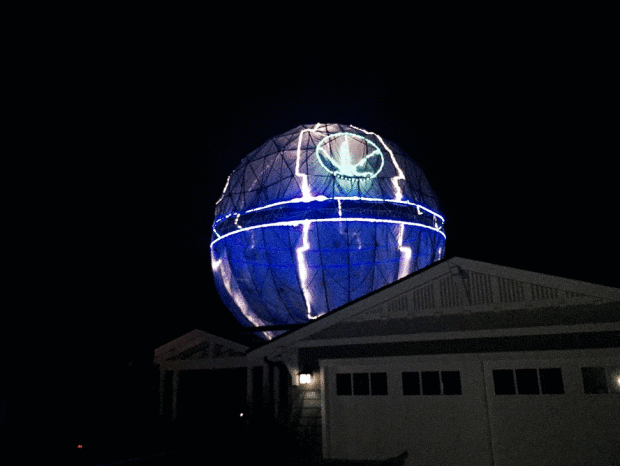
Imagine an actual Death Star so large it consumes a large portion of the sky over your neighborhood.
For Halloween — and with the imminent release of Star Wars: Episode VII looming — that’s exactly what Colby Powell and his kids built, a Death Star as tall as a two-story house, complete with a concave super laser dish and corresponding flashing lights.
Then to really sell this thing, Powell mounted the 23-foot-tall structure on the roof of his Lafayette, CA house for all to see and fear.
The idea for his build started after Powell’s young kids took a liking to the Star Wars movies. “We had this idea a couple years ago. Hey what if we put the Death Star in our back yard, and make it so big that from the front of the house you can see it over the house?” He explains. The planning began then, with some logistical modifications moving the idea from the back yard to top of his house. He didn’t feel that the time was right to actually pursue the construction, however, until this year, with his kids slightly older and the movie about to hit theaters.
To create his planet-destroying masterpiece, Powell and kids designed and built a 23′ geodesic sphere using 1/2″ grey electrical conduit (rather than white PVC, for a closer color match) and Sonostar hub couplers. He built the frame to fit the two grey-green T-10 military surplus parachutes he used for the shell, something which required a call to the lead engineer of the parachute manufacturer for dimensional information; the engineer found CAD drawings to determine seam lengths so Powell could calculate the inflated parachute height and with that the necessary shell size.
Construction of the sphere started as a family project until the size of it proved too large for the kids. At that point, something interesting occurred: “I had people drive by and say ‘Hey do you need a hand with that?'” Powell says, explaining that about two dozen people contributed to the assembly despite not knowing exactly what it was. Some thought it was a climbing structure. Another thought it was a biodome. One even joked it was a bomb shelter.
https://instagram.com/p/9Yw5Q_EdcTT26HxiBlHbzS72AoZkuAtItiUXs0/
Getting it onto the roof was as big an endeavor as the build itself.
“I work for a general contractor and we parked a 70 foot boom truck (crane) in the driveway to complete assembling the top hemispheres on the bottom hemisphere and hoist the Death Star onto the roof,” Powell details. “There was a lot of math involved to get the crane in proper position. Think about this — a 70 foot crane sounds enormous, but by the time you raise a 23′ sphere 10 feet in the air, and then allow enough extra cable (approx. 22′) to ‘lay’ the hook down beside the sphere after it is hoisted so that it can be disconnected from up on top of the roof without climbing a ladder (now it’s 55′ total), you’ve got to get this giant truck pretty darn close to the house to make it all work!”

Powell says that in his research, the largest Death Star he came across was one built at Legoland, which measured about 6′ in diameter — making his by far the largest he was aware of, although he’s reluctant to declare that officially.
He expects to leave it up until sometime between Thanksgiving and Christmas. After that he might store it, or sell it on eBay. He’s also considering sending it to Burning Man.
Final stats:
– 23′ in diameter
– 400 lbs in weight
– 2000′ of pipe, cut into 480 pieces
– 960 screw connections
– 162 hub connectors
– Six 40′ strands of white LED strip lights
– Three 30′ green LED strips
– Two circumferences of blue rope light for the equatorial trench

ADVERTISEMENT



















